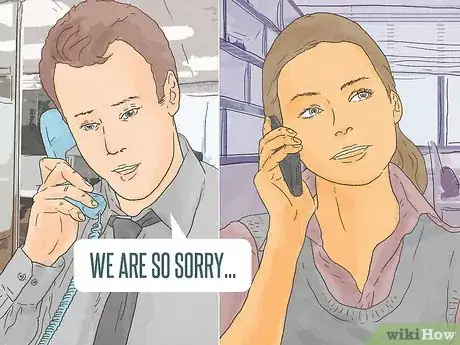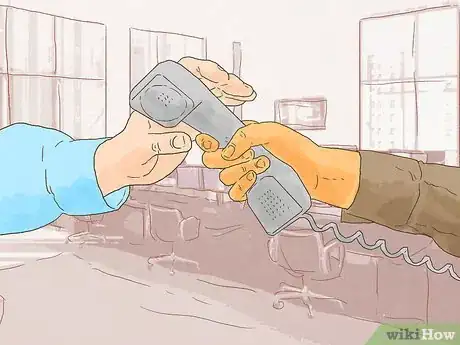This article was co-authored by Linda Chau. Linda Chau is a Public Relations Specialist and the CEO and Founder of PAAPR Agency (Public Attention And Public Relations). With over a decade of experience, she specializes in strategic planning, brand storytelling, press communication, and reputation management. Linda holds a BA from The University of California, Riverside and has been featured in AdAge, Austin Business Journal, and more.
wikiHow marks an article as reader-approved once it receives enough positive feedback. In this case, 90% of readers who voted found the article helpful, earning it our reader-approved status.
This article has been viewed 617,245 times.
If you work in customer service or own a business, you will occasionally need to take calls from angry customers. How you handle these calls can determine the quality of reviews you receive and the success of your business. The most important thing to do is stay calm. Make them feel listened to before you offer solutions. If the customer's anger is escalating out of control, try to calm them down, but know when to step away.
Things You Should Know
- Making the customer feel heard and understood is key to diffusing their anger.
- Be sympathetic, patient, and try to fix the problem. The customer wants to know that somebody is on their side.
- Ask questions to deescalate difficult situations. This can help refocus the customer's mind on the facts rather than their heightened feelings.
Steps
Remaining Calm
-
1Do not react. Keeping calm is key; reactions such as anxiousness or anger--while natural--will make things worse. If the customer views you as calm and professional, the customer will tend to "mirror" your reaction.
- Try focusing on your breathing, by taking deep, calm breaths.
- Do not be obvious about breathing heavily, however--it may come across as creepy or sighing.
-
2Allow venting. Let the angry client talk through their problems and explain all the reasons they’re unhappy. Do not interrupt. If you have a question, wait until the person is finished to ask it.[1]
- Be patient. This may take time on the customer's part.
- Do not argue, contradict, or otherwise engage in a fight, even if the customer is patently wrong. This is particularly important while handling irate customers in a call center, at a help desk, or in a similar setting.
- If the customer feels heard, it is often the most important part of the interaction. Customers will often eventually become much more agreeable just because they are listened to, sometimes even if the issue cannot be handled.
- Give the customer your full attention and let the customer communicate their frustrations or concerns before providing a solution.
Advertisement -
3It's not personal. An angry customer probably won't be careful about the specific language they use. When they say, "You messed this up," they usually mean the company messed up. Remember that this isn't about you, and taking it personally will stress you out unnecessarily.[2]
-
4Encourage them with brief verbal prompts. The customer cannot see you, so some verbal feedback helps reassure that the line has not gone dead, and you are listening.
- As they talk, make indications that you are listening, such as "Uh huh,” “Okay,” and “Oh, wow.” This will assure them that you are paying attention and make them feel like you want to hear the whole story.[3]
-
5Use a level voice. Your instinct may be to raise your voice in response to being yelled at, but this will only make matters worse. It will escalate the conversation to an argument, and the customer won't trust you to help them. Keep your voice level throughout the call, never speaking above a normal conversational tone.[4]
Offering Solutions
-
1Summarize the situation in your own words. Show you were listening by repeating the main points of the story back to them in your own words. Start by saying “Let’s see if I’m clear on this…” or “So basically what happened was…” This will also help ensure that you and the customer are both on the same page about what the issue is.[5]
-
2Be sympathetic. Let the customer know that you understand how frustrated they are. Put yourself in their shoes and think about how they must have felt in this situation. Use phrases like "I can imagine how upsetting that must have been" or “That must have been so irritating.”[6]
- Do this even if you think the customer was negligent, idiotic, or just plain wrong.
- Remember your job is not to judge the customer.
-
3Apologize when it’s appropriate. If the problem was caused by something you or another employee did, apologize to the customer for the mistake. If the problem is a result of something the customer did wrong, you don’t need to apologize. You can simply say, “That’s not what we want, so let’s see what we can do to make it right.”[7]
- An example of a possible apology is “I’m so sorry we messed up your order and caused this inconvenience. Let’s talk about how we can make it up to you.”
- Another: "It looks like there was an issue on your order. I'm so sorry that happened. We can have a replacement for you in two days. Should I ship it to your work or home address?"
-
4Offer to try to fix the problem (if possible). In general, training for customer service will cover the most common issues that arise. But weird and oddball things happen. And sometimes customers claim questionable events happened to demand a "replacement".
- Avoid promising to outright fix the issue since that may not be possible. But always promise to attempt a solution.
- Use phrases like, “Let me see what I can do” and “I’m going to try to get this sorted out.”and "I want to be sure to get you in touch with the right person to handle this issue".
-
5Use positive statements whenever possible. The customer will want to know what you can do for them, not what you can't do. Use positive language instead of words like "no," "can't," or "won't." Even if what they want isn't possible, try saying, "What if we offered you this instead?"[8]
Dealing with Escalating Anger
-
1Ask questions to calm the customer down. Rather than arguing with the customer, ask questions to focus their mind on the facts. Try asking them to clarify a couple of details from their story, or ask them how they want to see the situation remedied.[9]
- For example, you could ask, “What’s your ideal solution to this issue?”
-
2Stop the customer if they become directly abusive toward you. Allow them to communicate their feelings, but if they begin to call you names or use explicit language, cut them off. Tell them what the consequences will be if they continue speaking in this manner.[10]
- For example, you could say, “Sir, I understand that you’re frustrated, but if you continue to use that kind of language I’ll have to end the call.”
- If you don’t own the business, make sure you know ahead of time what your company’s policy is regarding abusive language. Your employer should have a written rule about when it’s acceptable to disconnect a call.
-
3Respect the customer’s wishes to speak with a supervisor. The customer may be so fed up with the situation that they ask to speak to someone in a position of power. Don’t take this personally or get defensive if they demand it; just oblige them and pass them on to your manager.
- If you’re the manager or owner, politely tell them so by saying, “I am the manager on duty. I’d like to hear your story and work on a solution with you.”
-
4Thank them for bringing the issue to your attention. Making the customer feel appreciated may help to defuse some of their anger. Show them that you view their call not as an inconvenience, but as an opportunity to improve.
- Try finishing the interaction with a quick “Thank you for letting us know about this. We don’t want this to happen again.”
-
5Take time to unwind after the call. Calls like this can be emotionally draining, so if you have the chance, take a break. Step outside to take a quick walk around the block. Head to the break room to grab a cup of coffee and chat with a coworker. Or just take five minutes at your desk to meditate and take deep breaths.[11]
Community Q&A
-
QuestionHow do I deal with a repeat customer who files false complaints?
 Community AnswerTreat this form of complaint as legitimate one, attempt to get the complainant's details and create a record of the complaints. You will soon notice a pattern, who they are aimed at and whether their intentions are nefarious in nature. Then you could sit down with your manager and discuss a method in which to reach a resolution.
Community AnswerTreat this form of complaint as legitimate one, attempt to get the complainant's details and create a record of the complaints. You will soon notice a pattern, who they are aimed at and whether their intentions are nefarious in nature. Then you could sit down with your manager and discuss a method in which to reach a resolution. -
QuestionWhat if the customer doesn't like the final decision?
 Heather Kenyon-HaffTop AnswererSometimes customers will not be happy with the outcome, even if everything possible was done to address the situation. Sometimes the customer has inappropriate expectations or wants something to happen that is not possible. The customer is not always right.
Heather Kenyon-HaffTop AnswererSometimes customers will not be happy with the outcome, even if everything possible was done to address the situation. Sometimes the customer has inappropriate expectations or wants something to happen that is not possible. The customer is not always right. -
QuestionWhat if the irate customer said that she wants to talk to the manager?
 Community AnswerBe obliging and say something like: "I can imagine how upsetting that must have been but don't worry, I am here for your help and my manager will also advise you the same that I am going to advise you." If they keep insisting, then you can get the manager.
Community AnswerBe obliging and say something like: "I can imagine how upsetting that must have been but don't worry, I am here for your help and my manager will also advise you the same that I am going to advise you." If they keep insisting, then you can get the manager.
References
- ↑ https://service.asu.edu/blog/strategy-dealing-angry-customers
- ↑ https://www.entrepreneur.com/article/290788#
- ↑ https://psychcentral.com/lib/become-a-better-listener-active-listening/
- ↑ https://www.entrepreneur.com/article/290788#
- ↑ https://psychcentral.com/lib/become-a-better-listener-active-listening/
- ↑ https://service.asu.edu/blog/strategy-dealing-angry-customers
- ↑ https://service.asu.edu/blog/strategy-dealing-angry-customers
- ↑ https://www.callcentrehelper.com/dealing-with-angry-customers-152.htm
- ↑ https://www.entrepreneur.com/article/290788#


























-in-US-Step-10-Version-2.webp)















































